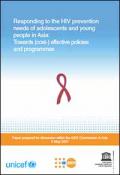Publications - Released in 2007
The major recommendation of this paper is to strongly increase resources available for age- and gender- appropriate HIV prevention and support services for young people engaging in high risk behaviors: injecting drug users, young women and men involved in sex work and young men who have sex with men.
The coverage of comprehensive interventions that specifically reach these young people should be scaled up to reach 50% in 2010 and 80% in 2015.
Despite the huge difference in physical and cognitive development levels within the age group of 10 to 24 year olds (defined as adolescents and young people) the current HIV prevention services for people engaging in high risk behaviors are not age-specific. For the age group of 18 to 24, operations research is needed to study whether the effectiveness of existing programs can be further increased by making them more appropriate. For those under 18, it is proposed that, in principle, interventions should aim at providing alternatives to the behaviors in question and preventing exploitation. For those who have no alternative or do not wish to change their behavior, the paper urges a rights-based approach aimed at reducing harm to the child – i.e. they should not be withheld their right to access prevention services because of their young age.
Downloads
Organizations
- United Nations Children’s Fund (UNICEF)
- United Nations Population Fund (UNFPA)
- United Nations Educational, Scientific and Cultural Organization (UNESCO)






